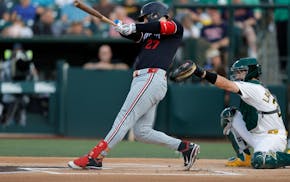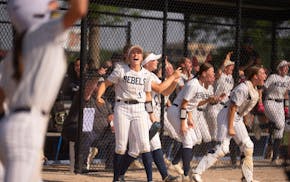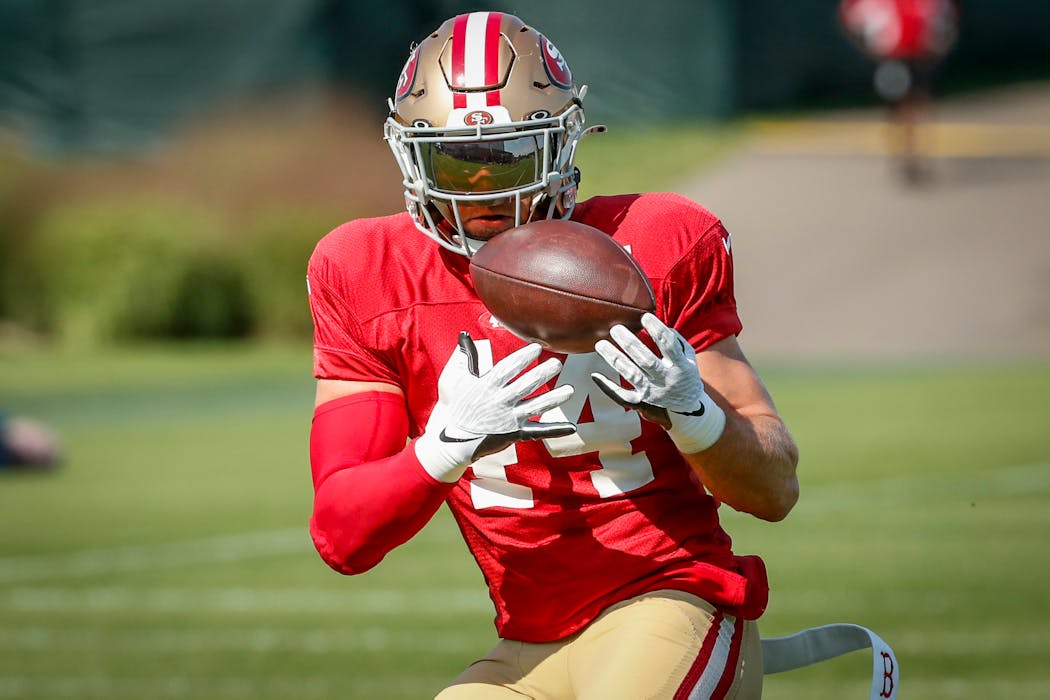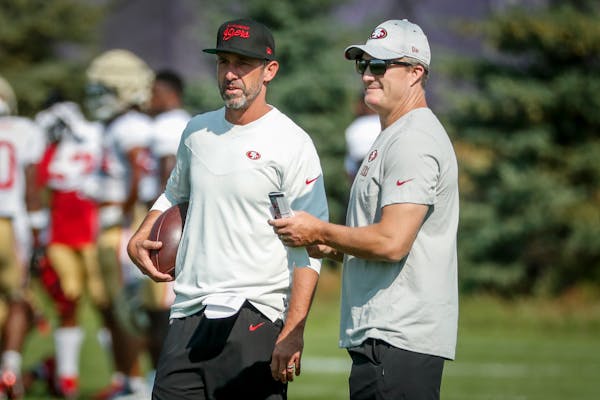Kyle Juszczyk doesn't hear the typical grievance from C.J. Ham.
When the 49ers fullback meets with the Vikings fullback after Saturday's preseason game at U.S. Bank Stadium, the two won't be lamenting their roles in an evolving NFL. Because of the position's dwindling usage over the past decade, both Pro Bowl fullbacks have a habit of finding their counterparts after games. The fullback fraternity, as Juszczyk referred to it, sticks together with a common envy of the 49ers' do-it-all back.
"That's usually the conversation," Juszczyk said. "It's like, 'Man, so jealous how much they use you.' I'm like, 'I know, I wish they used you the same way.' "
No NFL fullback is deployed as often as Juszczyk in San Francisco, where the 49ers have leaned on him as the most versatile and highest-paid player at the position.
Ham has had little objection in Minnesota, seeing as only three fullbacks – Juszczyk, Ham and the Ravens' Patrick Ricard – reached at least 30% playing time each of the past three seasons. Fourteen fullbacks hit that mark a decade ago.
"Everybody talks about how there's just not that many fullbacks in the league no more or teams are getting away from it," Ham said. "So when we play against a team that has a fullback, it's that brotherhood. Some of the last few, if you say."
'More on his plate'
To have a place in today's NFL, fullbacks must be more than road graders. Other than lead blocking for Dalvin Cook, whose 35 rushing touchdowns since 2019 trail only the Titans' Derrick Henry, Ham has thrived in a diverse role in offenses under former Vikings assistant Gary Kubiak and his son and former coordinator Klint Kubiak.
As a catch-and-run target since 2019, Ham caught 42 passes for 371 yards and two touchdowns. He aligns anywhere on the field, averaging 30 snaps per season split out wide or in the slot, often to move a defender away from the front. The Vikings leaned into his strength last year, making him an in-line blocker – like a tight end – on more than a quarter of his snaps, according to Pro Football Focus.
Will new head coach Kevin O'Connell, who coordinated a Rams offense that deployed three receivers more than any team in a Super Bowl-winning season, keep Ham involved?
"I'm here. I'm employed," Ham said. "I'm excited for the opportunity they have for me."
O'Connell has been effusive in his praise of Ham and the roles he envisions for the versatile fullback. Running game coordinator Curtis Modkins, previously as a running backs coach, has overseen prominent roles for fullbacks Andy Janovich in Denver and Michael Burton in Detroit and Chicago.
Ham, also a core special teams contributor, was worth retaining on his four-year, $12 million contract by new leadership that needed both salary cap space and good players.
"He's really able to take much more on his plate than the traditional fullback," O'Connell said. "He can mentally handle it, but then, B, he's a dynamic player. To have the strength in the run game, the understanding to be able to do some unique run game concepts with him and then ultimately use him as a weapon in the pass game."
"We're going to try to activate C.J. in a lot of ways," he added.
Juszczyk said he studies many NFL fullbacks, including Ham, whose left his mark on opponents by moving bodies and catching defenders off guard.
"I just like his physicality," Juszczyk said. "He's one of the more physical guys in the league. That's what I get from him. … He's good with the ball in his hands. I feel people sleep on him when it comes to that."
Leading the way
There's no other fullback quite like Juszczyk, who has fronted 49ers coach Kyle Shanahan's potent run schemes as well as aligned at tight end, out wide or as the third-down running back.
For six straight seasons, including the past five in San Francisco, Juszczyk has led all fullbacks in playing time. Lead blocking is only part of his role. The 49ers have given him at least 30 touches, including about 20 catches per season, as a mismatch on offense.
"It allows us to dictate things to the defense," Shanahan said in 2019. "You can begin in certain personnel groupings that are impossible to run against if you don't have a fullback. So, if you have a fullback in there, they know you can run it at any time, which simplifies a little bit of what the defense is doing. Also, if we can move that fullback to different positions to where he's not actually playing fullback, then it gives us an advantage."
Juszczyk is one of the slighter players at his position. Listed at 6-2 and 235 pounds, he is 3 inches taller and 15 pounds lighter than Ham, who pointed to Juszczyk's intelligence as the separator. Shanahan's system has "a lot more flavor, a lot more game planning," Juszczyk said, meaning it's just "a little more complicated" for players.
"He's so smart, I think that's what sets him apart," Ham said. "He's not the biggest individual, probably not even the strongest, but he's just so smart in what he does knowing his assignment and knowing angles."
Fullback usage has declined in the NFL as teams opt to spread the formations, throw the ball and then run against lighter defensive fronts. Many coaches, like the Rams' Sean McVay, pick tight ends to fill lead-blocking roles, which was a primary job for Vikings tight end Johnny Mundt in Los Angeles.
But Juszczyk sees linebackers getting smaller. Front offices have been drafting quickness over power at the position to counter game-breaking tight ends and running backs in the passing game. The Vikings' Brian Asamoah, the rookie third-round linebacker who is listed at 6 feet and 226 pounds, is one recent example.
Is there a fullback comeback on the horizon?
"So much in this league is cyclical," Juszczyk said. "Now linebackers are former nickel [corners], former safeties. They're adapting. I think the next transition is OK, you bring back the fullback, the two tight ends, the bigger guys that can move the smaller linebackers.
"It's just going to keep going around and around. We're all adjusting off each other. I do think there will be a resurgence in the fullback."

Pair of home runs help Twins roll to another victory over Athletics, 6-1

Softball state tournament, live from North Mankato: Bloomington Jefferson, Champlin Park reach 4A final
Twins starter López has Grade 2 shoulder strain, expected to miss 2-3 months
Festa gets his wake-up calls and joins Twins in Sacramento



